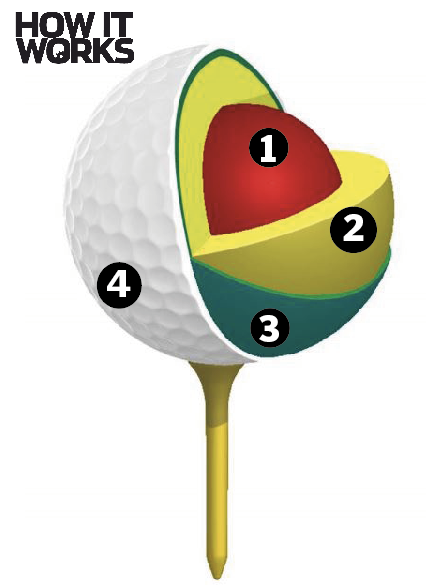Golf ball anatomy
by Ailsa Harvey · 15/11/2019
Professional balls are specially engineered to maximise your game

At their simplest, golf balls are made from a single layer of scratch-resistant resin. These basic balls are hard wearing and fly long distances through the air, but most balls have more than one layer. Two-piece balls have a hard plastic core for extra distance, and three-piece balls contain a rubber core coated with wraps of rubber banding. The outer layer can also be changed, swapping the tough coating for softer materials like urethane. These balls don’t go quite as far, but they can take more spin on short shots, giving professionals much more control.
However, there’s one key feature that makes golf balls stand out; their dimples. The game was originally played with smooth balls, but players noticed that older balls went further. These battered balls were covered in scratches and dents, and the change to the surface altered the air flow.
Air wraps around the curve of a ball as it flies through the air, and some molecules stick to the surface creating a ‘boundary layer’. But the air behind smooth balls detaches from the surface and sticks to the fast-moving air rushing past. This detached airflow in the wake of the ball creates drag. By coating the ball in dimples, the airflow becomes turbulent. This increases the initial drag but creates a thicker boundary layer that helps the air to cling to the ball at the back, thereby decreasing the size of the wake and helping to generate even more lift. Subtle changes to the dimples tweak the exact dynamics of each ball design.
What's in a golf ball?

The inside of a golf ball is made of springy rubber. The harder the ball, the further it will go.
The outer core is also made of springy rubber. Some golf balls only have one inner layer.
Some balls have a tough fouth layer that sits between the core and the outer.
The outside is millimetres thick and designed to resist damage. The softer the outer, the more the ball will spin.
Different balls are coated with a different number of dimples, varying in shape and size. Most have between 300-500.
This article was originally published in How It Works issue 104, written by Laura Mears
For more science and technology articles, pick up the latest copy of How It Works from all good retailers or from our website now. If you have a tablet or smartphone, you can also download the digital version onto your iOS or Android device. To make sure you never miss an issue of How It Works magazine, subscribe today!




